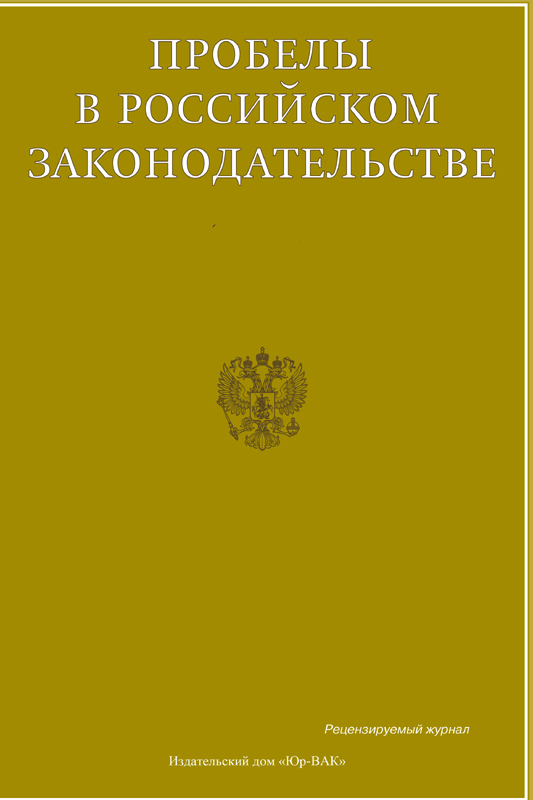Some Features of the Criminal’s Personality in the Sphere of Real Estate Turnover
- 作者: Kvasnikova Т.V.1
-
隶属关系:
- Far Eastern Federal University
- 期: 卷 16, 编号 3 (2023)
- 页面: 165-170
- 栏目: Criminal Law Sciences
- URL: https://journals.eco-vector.com/2072-3164/article/view/568821
- EDN: https://elibrary.ru/GDZUVR
- ID: 568821
如何引用文章
详细
The article presents the results of a comparative legal study of the personal characteristics of persons who have committed crimes in the sphere of real estate turnover and persons who have committed general crimes in the field of economic activity and against state power and the interests of the civil service, which made it possible to identify their significant differences. It is interesting fact is that the personal characteristics of the designated criminals differ not only in the level of upbringing, education, intelligence, official position, but also the criminal motivation for committing crimes varies. In the course of the study, the personal characteristics of the designated groups of criminals are compared and an analysis is presented, the results of which can be useful for predicting the further behavior of persons prone to committing crimes and the applying individual prevention measures to persons who have committed crimes.
The purpose of the study: to conduct a comparative legal analysis of persons who have committed crimes in the sphere of real estate turnover and persons who have committed crimes of a common criminal orientation, in the sphere of economic activity and against state power and the interests of public service.
The methodological basis of the work is a comparative legal approach, which allowed for a comparative analysis of the socio-criminological characteristics of persons who have committed crimes of a common criminal orientation and persons who have committed crimes in the sphere of real estate turnover, an analytical method by which the compared personality characteristics are investigated and distinctive features are highlighted, a static method that made it possible to study statistical indicators: compare age criminals, gender ratio, social status, etc., methods of synthesis and extrapolation, which made it possible to compare personality traits, etc.
全文:
作者简介
Тatiana Kvasnikova
Far Eastern Federal University
编辑信件的主要联系方式.
Email: kvasnikova.tv@dvfu.ru
Cand.Sci.(Law), Associate Professor of the Department of Criminal Law and Criminology
俄罗斯联邦, Vladivostok参考
- Antonyan Yu. M. Violence. Human. Society: Monograph. M.: VNII MVD of Russia, 2001. 246 p.
- Arneklev B. J., Elis L., & Medlicott S. Testing the genera! theory of crime: Comparing the tfacts с: imprudent behavior’ and an attitudina; indicator of ‘low self-control. Western Criminology Review, 7(3), 2006. 41-55 // https://www.researchgate.net/publication/288104829 (accessed 16.04.2021).
- Alalehto T. Economic crime: Does personality matters? International Journal of Offender Therapy and Comparative Criminology, 47(3), 2003. 1-22 // https://www.researchgate.net/publication/10705977_ (accessed 16.04.2021).
- Brightman H. Today’ s white collar crime: Legal, investigative and theoretical perspectives. New York: Routledge, 2009 // https://www.routledge.com/ (accessed 16.04.2021).
- Weisburd D. Crimes of the middle classes: Write-collar offenders in the federal courts. Yale University Press. 1991.
- Gottfredson М., & Hirschi T. A general theory of crime. Stanford: Stanford University Press, 1990 // https://archive.org/details/generaltheoryofc00gott (accessed 16.04.2021).
- Digman J.M. Personality structure: Emergence of the five-faktor model. Annual Review of Psychology, 41, 1990. 417-440 // https://www.scirp.org/reference/ReferencesPapers.aspx?ReferenceID=1045183 (accessed 16.04.2021).
- Costa P.T., & McCrae R.R. The NEO personality inventory. Odessa: Psychology Assessment Resources. 1985 // https://www.researchgate.net/publication/285086638_ (accessed 16.04.2021).
- Costa P.T., & McCrae R.R. NEO Pl-R professional manual. Odessa: Psychological Assessment Resources. 1992 // https://www.researchgate.net/publication/240133762_ (accessed 16.04.2021).
- McCrae R.R., & Costa P.T. NEO inventories professional manual for the NEO Personality Inventory-3, NEO Five-Faktor Inventory-3, and Personality Inventory-Revised. Lutz: PAR. 2010 // https://www.researchgate.net/publication/7834763_ (accessed 16.04.2021).
- McCrae R.R., & John O.P. An introduction to the five-faktor model and its applications. Journal of Personality, 60 (2), 1992. 175-215 // http://psych.colorado.edu/~carey/courses/psyc5112/readings/psnbig5_mccrae03.pdf (accessed 16.04.2021).
- Pinkevich T. V. Criminological and criminal law foundations for combating economic crime: dis. … Dr. jurid. Sciences / Pinkevich T. V. – Moscow, 2002. 414 p.
- Reed G., & Yeager P. Organizationa. offending and neoclassical criminology: Challenging the reach of a general theory of crime. Criminology, 34, 1996. 357-382 // https://elibrary.ru/item.asp?id=8589861 (accessed 16.04.2021).
- Simpson S., & Piquero N. Low self-control, organizational theory, and corporate crime. Law and Society Review, 36(3), 2002. Pp.509-548.
- Statistics and Analytics of the Ministry of Internal Affairs of the Russian Federation [Electronic resource] / URL: http://10.5.16/csi/ CSI «GIAC of the Ministry of Internal Affairs of Russia» (accessed 05.08.2022).
- Judge T.A., Heller D., & Mount M.K. Five- faktor model of personality and job satisfaction: A meta-analysis. Journal of Applied Psychology, 87 (3), 2002. 520-541 // https://www.researchgate.net/publication/11284305_ (accessed 16.04.2021).
- Wheeller S. White-collar crime and criminals. Faculty Scholarship Series. Paper 4127, 1988. https://digitalcommons.law.yale.edu/fss_papers/4127/ (accessed 15.04.2021).
- Wheeller S., Weisburd D., Waring E. & Bode N. Write-collar Crimes and Criminals. American Criminal Law Review, 25, 1998, Pp. 331-357.
- Ouimet М., & Le Blanc M. Life events in the continuation of the adult criminal career. Criminal Behavior and Mental Health, 6(1), 1996. Pp. 75-97.
补充文件








